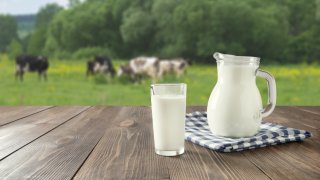

The following content is created in partnership with Florida Dairy Farmers. It does not reflect the work or opinions of NBC Miami’s editorial staff. Click here to learn more about Florida Dairy Farmers.
Visit the dairy section of your favorite grocery store and you’ll notice there are more milk options than ever before. With so many alternatives, it’s no wonder many struggle when choosing the right milk for themselves and their families.
So, how do you make an informed decision and choose what’s best for you and your loved ones? Here are some factors to keep in mind next time you’re at the supermarket:
329 medal events. 32 sports. Endless drama. Catch all the action at the Paris Olympics. Sign up for our free Olympics Headlines newsletter.
Read the nutritional label
Real cow’s milk has three simple ingredients: Milk, vitamin D and vitamin A. Compare that against milk imitators, like those made from plants or nuts. They often have long lists of added ingredients including salt, sugar, thickening agents and other ingredients designed to imitate the taste and texture of cow’s milk. Milk imitators are fortified and designed to try to match the nutritional profile of cow’s milk. And, last but not least, they’re usually more expensive.
Keep in mind that milk imitators are not technically milk and are not a natural nutritional equivalent to cow’s milk. Meanwhile, milk—including white, flavored, lactose-free, and organic—contains nine essential nutrients important for growth and development.
Boost immunity with vitamin D
As the pandemic continues and we enter the cold and flu season, Americans are turning to foods that can act as a supplement, helping to boost immunity and contribute to a sense of overall wellness. However, Americans aren’t getting enough vitamin D, and vitamin D deficiencies are associated with worsening autoimmune diseases. One glass of cow’s milk provides enough vitamin D to cover 20 percent of the average daily requirement of the nutrient.
Not all proteins are the same
When it comes to meeting your family’s daily protein requirements, not all foods are created equal. Most plant-based milk imitators don’t contain natural proteins, they’re added along many other ingredients. Dairy foods like milk, on the other hand, are a source of high-quality proteins because they contain essential amino acids the body can’t make on its own. Protein gives our bodies a power boost and satiety that help us feel fuller for longer. That’s why breakfast is the best time to consume protein, with experts recommending adults consume between 25-35 grams of protein first thing in the morning. Drinking one glass of milk provides 8 grams of high-quality protein. By comparison, you would need to eat about 10 cups of spinach to get the same amount of protein.
Sustainable nutrition
When deciding what to purchase and eat, many Americans now consider how sustainable foods and farming practices impact the environment. Thanks to innovative practices, dairy farmers are better stewards of the environment and sustainably producing milk, cheese and other dairy products. In fact, when compared with 75 years ago, the production of one gallon of milk requires 65 percent less water, 90 percent less land and 76 percent less manure. Those reductions translate into a 63 percent smaller carbon footprint of milk today. By 2050 the Dairy Industry has committed to be carbon neutral.
What about lactose intolerance?
Lactose intolerance is often mischaracterized as an allergy that requires the complete avoidance of dairy. However, lactose intolerance is the body’s inability to digest lactose—a natural sugar mainly found in dairy products. There are two important factors to consider when making an informed decision about lactose intolerance. First, it’s important to not self-diagnose if you think you are sensitive to lactose and get a diagnosis from a medical professional. Second, if you are lactose intolerant, it doesn’t mean you have to completely avoid dairy. For instance, there are brands that offer lactose-free milk. Some people think that lactose-free dairy foods taste the same as the traditional varieties, while others say they’re slightly sweeter. This additional sweetness is a result of the lactose neutralization process. Research shows that people prefer lactose-free milk to non-dairy alternatives. In addition to not missing out on the nutrients real milk offers, you can prepare your favorite recipes with lactose-free milk.
Milk and vegetarian or plant-based diets
If you’re leaning towards a meatless diet, remember that many plant-based protein sources might be incomplete, meaning they don’t have the same mix of essential amino acids that your body needs to be healthy and strong. Milk helps you by providing natural and high-quality protein, calcium and vitamin D. You would need to eat 21 cups of raw broccoli to get the same amount of calcium that milk provides in three glasses.
How to know if you’re buying local
There’s an easy way to know if your gallon of milk was produced in Florida: Look for a series of numbers—the plant code—near the sell-by date and if it starts with a 12, it comes from a Florida dairy farm. Nearly all of Florida’s dairy farms are primarily owned and operated by second and third-generation farmers who take great pride in producing the nutrient-rich milk we enjoy as well as in taking care of their cows and the environment.

